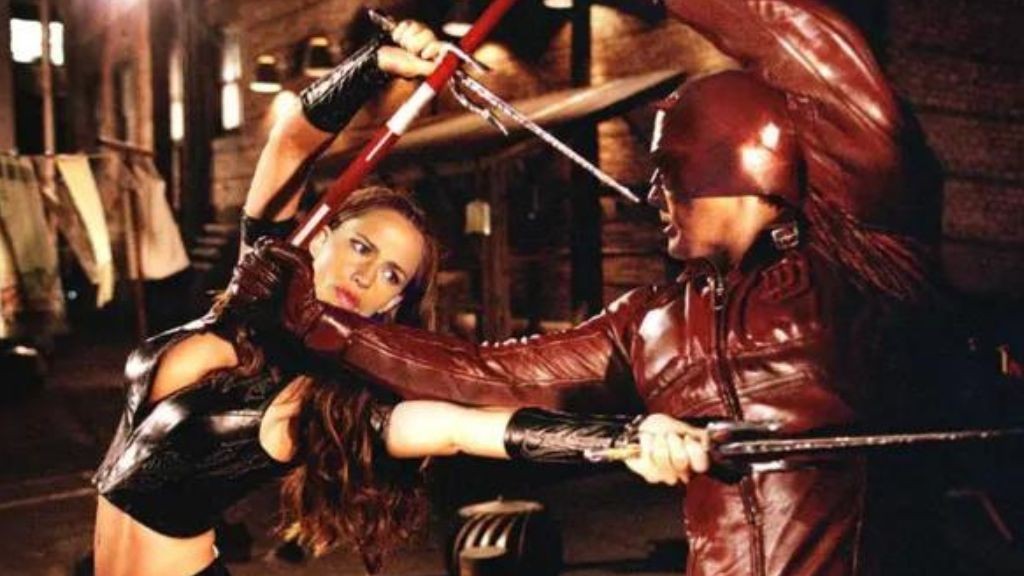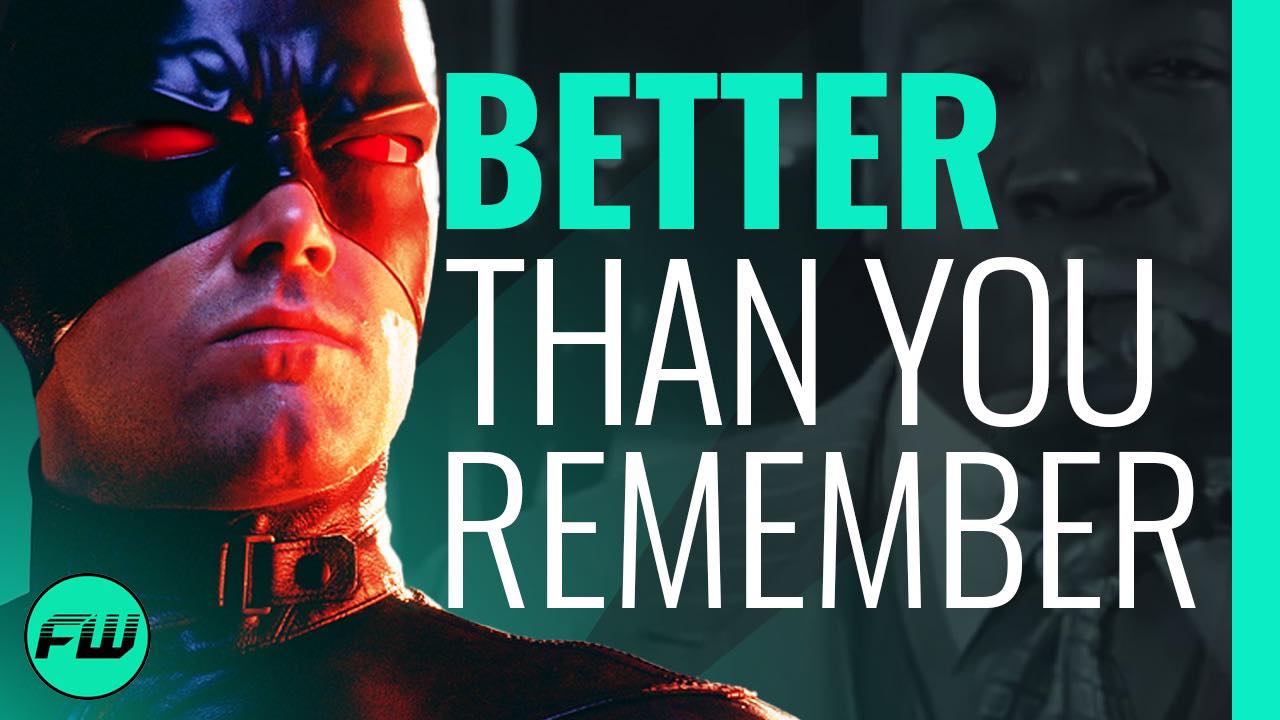In this FandomWire Video Essay, we explore why Daredevil (2003) is BETTER than you remember.
Check out the video below:
Subscribe & hit the Notification Bell so you never miss a video!
Daredevil (2003) Retrospective

This… is better than you remember.
Sure, it’s undoubtedly a product of its time, but this early 2000s attempt at a large-scale comic book adaptation was one of the first of its kind for Marvel, preceded immediately by Sam Raimi’s Spider-Man the previous year. It’s a unique film that took major creative swings, melding a gritty noir aesthetic with an abundance of absurdity. It featured two larger-than-life villains portrayed by Academy Award Nominated actors, questionable CGI intertwined with impressive fight choreography and, of course, Evanescence’s “Bring Me To Life.” Essentially, Daredevil is a time capsule of its era, showcasing the best and worst elements of a very specific filmmaker style, and it does it all with a fantastic performance from Ben Affleck at its core.
Mark Steven Johnson’s Daredevil, starring Ben Affleck as the eponymous superhero, was released in 2003 to a flurry of heavy criticism. Against its reported $78 million budget, the film made $102 million in the US and nearly $77 million abroad, totaling up to around $179 million. It was hardly the type of blockbuster one would associate with modern superhero movies.
The film didn’t fare much better critically, earning a measly 43% critics score on Rotten Tomatoes, with an even worse 35% audience score. It’s understandable why the film was so hated upon its release, as studio-mandated cuts created a 104-minute theatrical version that didn’t make a ton of sense.
However, like another Ben Affleck superhero vehicle, Batman v Superman: Dawn of Justice — whose Ultimate Edition we covered in a different video you should check out — Daredevil was salvaged by a director’s cut, adding in an impressive 25 minutes worth of additional content that both adds essential context to the story and makes it feel much more exciting and epic as a superhero action film.

But why is it that the 2003 Daredevil movie deserves a better reputation than it has gotten?
Ultimately, the 2000s superhero movie is a lost art. There were two movies that revolutionized the way comic book adaptations would be made: Iron Man in 2007 and The Dark Knight in 2008. Iron Man gave us superhero blockbusters that were heavy on the comedy and didn’t take themselves too seriously, and The Dark Knight made superhero movies that were much darker and more “intelligent” viable.
Although there are of course some exceptions that went against the grain — Sam Raimi’s Spider-Man movies come to mind — most superhero movies of the early 2000s were unquestionably silly films, delivering over-the-top content with a straight face. They weren’t trying to be cerebral cinema for grown-ups, but they also weren’t cracking jokes every ten seconds. They had a balance to them.
They had a balance to them and Daredevil really nails that balance, giving audiences their first look at a live-action interpretation of the Man Without Fear. You feel like you’re going on a larger-than-life adventure. The film demands a suspension of disbelief, as do most comic book films, but if you allow yourself to become immersed within its world the journey is likely to be a fun one.
The early 2000s elements, most of which feel extremely dated by today’s standards, are abundantly clear upon a rewatch. Who can forget the scene where Daredevil and Elektra prepare for battle, while Evanescence’s “Bring Me To Life” plays in the background, completely unironically? However, it is flourishes like this — clearly a product of their time — that make this a perfect relic of 2000s superhero cinema.
One of the things Daredevil does best is create a dark, moody, and rainy atmosphere that makes the Hell’s Kitchen setting feel very reminiscent of DC’s Gotham City. In the Netflix series, which first began streaming to much fanfare and acclaim in 2015, the world feels much more grounded, but in the 2003 film, it feels like we’re seeing an alternate, more comic-esque reality than our own world. It’s in line with many of the comic adaptations we had seen up to that point, like the Burton and Schumacher Batman series or the Blade movies.
It’s fitting that the Hell’s Kitchen we see in Daredevil feels so much like Gotham City, as many fans cite the character of Daredevil as Marvel’s answer to Batman. Both are very detective-like in nature, with heavy inspiration from the film noir genre.
One of the ways in which the noir influence of the film can be seen is Jennifer Garner’s performance as the hero’s love interest, and secret assassin, Elektra Natchios. And before you ask — no, we’re not going to praise the 2005 spin-off Garner supposedly didn’t want to do, but had to out of contractual obligation. That one’s legitimately not good.
But in terms of her role in Daredevil, Garner certainly understood the assignment. In many ways, Elektra represents this movie’s version of the noir trope of the “femme fatale,” a French phrase which translates into “deadly woman.” Normally, it represents the type of duplicitous woman with an ulterior motive that serves as a seductress to our hero. Think Mary Astor’s role in The Maltese Falcon or Eva Marie Saint in North by Northwest.
However, there’s hardly a more literal interpretation of the femme fatale than a woman who is literally a killer, as Elektra Natchios is in the 2003 Daredevil. And Garner does an excellent job of playing into this archetype. She’s both extremely alluring and confident in the role. It should also come as no surprise that Garner and Affleck have excellent chemistry together, considering the duo would get married a few years later.
While the film noir influences are arguably the most pronounced, there are other genres that Daredevil is often in conversation with — one of the main ones being martial arts cinema. There are a few martial arts action scenes with some impressive, if campy, choreography. Of course, as is the case with many early 2000s superhero movies, there’s an abundance of ridiculous CGI that undermines some of the hand-to-hand combat. However, when the fights are able to speak for themselves, they are strong.
One of the most prominent tropes of the martial arts genre present in Daredevil is the Blind Warrior. Of course, fans know that Daredevil’s extraordinary fighting abilities were given to him by the fact that he lost his sight in an accident when he was a child, and the incident also led to his remaining senses amplifying, most prominently his hearing.
This blindness lends itself to a more than one fight scene — including the one in which the hero fights Elektra while still dressed as lawyer Matt Murdock — that showcase some of the more impressive combat from this era. It’s a great way to inject some energy into the film, especially since many of these scenes come early on.
Additionally, one could say Daredevil was ahead of the game in terms of paying homage to the Blind Warrior martial arts trope. This archetype has since been used by numerous franchises in American cinema, like in Rogue One: A Star Wars Story and John Wick: Chapter 4, with both characters, interestingly enough, being portrayed by Donnie Yen.
The film also uses the character’s blindness to its advantage by creating scenes that use visual effects to show Daredevil’s power of echolocation. We see this early in one scene, where Murdock uses the rain to “see” Elektra’s face, but the more prominent use is in the climactic battle against Kingpin, where it often cuts to this viewpoint throughout the fight.
The one aspect of the film that does tend to get a lot of praise is Ben Affleck’s performance in the leading role. By 2003, Affleck was already well established and with a handful of leading man roles under his belt with Armageddon, Pearl Harbor, and The Sum of All Fears. Daredevil was arguably his most ambitious undertaking as an actor yet — and despite the script not giving him the best or most substantial dialogue to work with, he does make the most of his role.
Of course, Affleck would eventually return to the superhero genre, playing Batman in Zack Snyder’s Batman v Superman: Dawn of Justice, Justice League, and making cameos in other movies in the DC Extended Universe. You can certainly see the foundations of Affleck’s future performance as the Caped Crusader in his turn as the Man Without Fear.
His performance as Matt Murdock has an almost arrogant confidence, which lends itself perfectly to Affleck’s Bruce Wayne (especially when we see him in the more comedic The Flash), but also an undercurrent of sadness and grief. The dichotomy that Affleck shows in this role is effectively a precursor to his later work.
However, even though Affleck may be the hero in the film, Michael Clarke Duncan’s take on the crime lord turned villain Kingpin is an absolute scene-stealer. Especially in the Director’s Cut version of the film, Duncan’s Wilson Fisk is both wonderfully intimidating and deceitfully charming — pulling off precisely what the role of one of the most influential villains in Marvel Comics calls for.
Michael Clarke Duncan’s turn as Wilson Fisk is a unique performance within his filmography. Arguably, his most well-known and acclaimed role was as gentle giant John Coffey in The Green Mile. These two characters are essentially night and day depictions, showing the incredible range Duncan had as an actor.
Although Vincent D’Onofrio’s version of Kingpin from the Netflix Daredevil is more acclaimed — and his is definitely great in many ways as well — Duncan’s is arguably the better Wilson Fisk. Although D’Onofrio is undeniably menacing as Kingpin, he lacks the level of sly charm that Duncan brings to the screen.
But Kingpin isn’t the only comic book villain we see brought to life in Daredevil. We also get to see Irish actor Colin Farrell play baddie Bullseye. Although Farrell’s performance as the secondary antagonist is much more ridiculous and campy, it provides a nice bit of brevity in an otherwise oppressively dark and moody film.
And that’s not to say Farrell’s Bullseye isn’t villainous or intimidating — especially in the director’s cut, where his actions are a bit more violent and devastating. However, whereas Duncan’s Kingpin is more one-dimensional with his dominating presence, Farrell’s Bullseye is off-putting because of his absurd and wacky lunacy. Farrell perfectly captures the “screw loose” aspect of the character, and that makes the role work well.
When looking at Daredevil it’s important to understand the film they’re trying to make. When comparing this 2003 outing to something like The Dark Knight Trilogy, or even most of the MCU, there is a clear and present disconnect. Daredevil isn’t striving to be highbrow cinema but instead strives to bring a beloved character from the pages to the big screen in an entertaining manner.
Daredevil is fundamentally a superhero movie designed for an audience in 2003. It’s messy, it’s campy, and it’s often ridiculous — but it’s fun, and it offers an interesting interpretation of these characters with some genuinely strong performances in the roles.
Maybe it’s time Daredevil received a re-evaluation, and perhaps when viewed through the lenses of hindsight we can recognize it for what it was: one of the more enjoyable films to come out of the early wave of comic book movies.
What do you think? Is the 2003 Daredevil movie better than people give it credit for? Or is it really just a massive stinker? Be sure to let us know in the comments below, and be sure to like and subscribe. As always, until next time!
Follow us for more entertainment coverage on Facebook, Twitter, Instagram, and YouTube.

